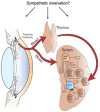"Corneal Nerves, CD11c+ Dendritic Cells and Their Impact on Ocular Immune Privilege"
- PMID: 34220866
- PMCID: PMC8253307
- DOI: 10.3389/fimmu.2021.701935
"Corneal Nerves, CD11c+ Dendritic Cells and Their Impact on Ocular Immune Privilege"
Abstract
The eye and the brain have limited capacities for regeneration and as such, immune-mediated inflammation can produce devastating consequences in the form of neurodegenerative diseases of the central nervous system or blindness as a result of ocular inflammatory diseases such as uveitis. Accordingly, both the eye and the brain are designed to limit immune responses and inflammation - a condition known as "immune privilege". Immune privilege is sustained by physiological, anatomical, and regulatory processes that conspire to restrict both adaptive and innate immune responses.
Keywords: contrasuppressor cells; cornea; dendritic cells; immune privilege; nerves.
Copyright © 2021 Niederkorn.
Conflict of interest statement
The author declares that the research was conducted in the absence of any commercial or financial relationships that could be construed as a potential conflict of interest.
Figures




Similar articles
-
Induction of Contrasuppressor Cells and Loss of Immune Privilege Produced by Corneal Nerve Ablation.Invest Ophthalmol Vis Sci. 2018 Sep 4;59(11):4738-4747. doi: 10.1167/iovs.18-24894. Invest Ophthalmol Vis Sci. 2018. PMID: 30267096 Free PMC article.
-
Immune Checkpoints Contribute Corneal Immune Privilege: Implications for Dry Eye Associated with Checkpoint Inhibitors.Int J Mol Sci. 2020 May 31;21(11):3962. doi: 10.3390/ijms21113962. Int J Mol Sci. 2020. PMID: 32486493 Free PMC article. Review.
-
[Hypothesis of immune privilege of the cornea and pathophysiology of graft rejection].Vestn Oftalmol. 2016;132(5):117-124. doi: 10.17116/oftalma20161325117-124. Vestn Oftalmol. 2016. PMID: 28635736 Review. Russian.
-
Corneal Nerve Ablation Abolishes Ocular Immune Privilege by Downregulating CD103 on T Regulatory Cells.Invest Ophthalmol Vis Sci. 2020 Apr 9;61(4):25. doi: 10.1167/iovs.61.4.25. Invest Ophthalmol Vis Sci. 2020. PMID: 32305043 Free PMC article.
-
Bilateral Alterations in Corneal Nerves, Dendritic Cells, and Tear Cytokine Levels in Ocular Surface Disease.Cornea. 2016 Nov;35 Suppl 1(Suppl 1):S65-S70. doi: 10.1097/ICO.0000000000000989. Cornea. 2016. PMID: 27617877 Free PMC article. Review.
Cited by
-
In Vivo Visualization of Intravascular Patrolling Immune Cells in the Primate Eye.Invest Ophthalmol Vis Sci. 2024 Sep 3;65(11):23. doi: 10.1167/iovs.65.11.23. Invest Ophthalmol Vis Sci. 2024. PMID: 39283618 Free PMC article.
-
TRPA1 and TPRV1 Ion Channels Are Required for Contact Lens-Induced Corneal Parainflammation and Can Modulate Levels of Resident Corneal Immune Cells.Invest Ophthalmol Vis Sci. 2023 Aug 1;64(11):21. doi: 10.1167/iovs.64.11.21. Invest Ophthalmol Vis Sci. 2023. PMID: 37585189 Free PMC article.
-
IL-1β-Mediated Immunometabolic Adaptation in Corneal Epithelial Cells.J Inflamm Res. 2025 Jul 18;18:9537-9555. doi: 10.2147/JIR.S495323. eCollection 2025. J Inflamm Res. 2025. PMID: 40697419 Free PMC article.
-
Infectious Eye Diseases and Prevention Control.Microorganisms. 2023 May 15;11(5):1286. doi: 10.3390/microorganisms11051286. Microorganisms. 2023. PMID: 37317260 Free PMC article.
-
Taxifolin Inhibits the Growth of Non-Small-Cell Lung Cancer via Downregulating Genes Displaying Novel and Robust Associations with Immune Evasion Factors.Cancers (Basel). 2023 Sep 30;15(19):4818. doi: 10.3390/cancers15194818. Cancers (Basel). 2023. PMID: 37835514 Free PMC article.
References
Publication types
MeSH terms
Substances
Grants and funding
LinkOut - more resources
Full Text Sources
Research Materials

